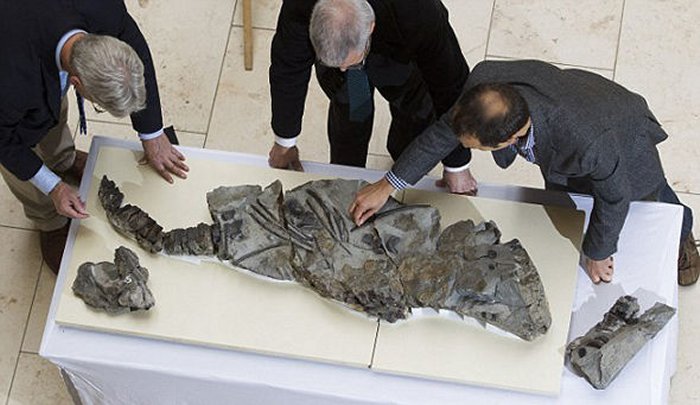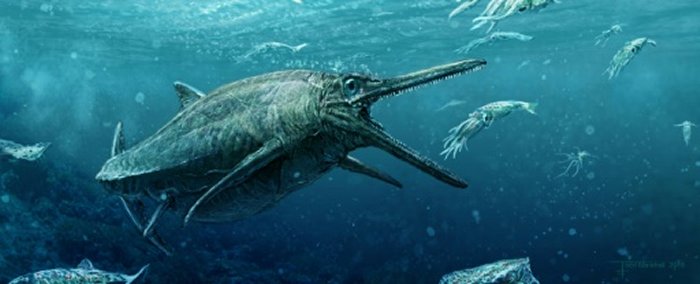MessageToEagle.com – Scientists have announced they have uncovered fossilized remains of a huge sea monster that once in the past roamed Scottish waters.
Known as the Storr Lochs Monster this giant prehistoric monster was first discovered by an amateur on a beach on the in 1966 close to the Storr Loch Power Station. It was presented to the he National Museum of Scotland. It has now just been removed from the rock in which it had become fossilized.

The creature is four-metre-long (13 feet) deep-sea killer-its pointed mouth bristling with hundreds of cone-shaped teeth.
“It is spectacular,” said palaeontologist Steve Brusatte of the University of Edinburgh’s School of Geosciences, who helped expose the 170 million-year-old remains.
The reptile belonged to the ichthyosaur family-scary-looking, finned hunters sometimes called sea dragons-that died out shortly before the dinosaurs, to be replaced by dolphins and whales.

Ichthyosaurs like the Storr Lochs monster ruled the waves while dinosaurs thundered across the land.
“For half a century the museum kept the fossil safe and secure, but there wasn’t the expertise to free it from the very dense rock that surrounded it, or the expertise to study it,” Brusatte said.
See also:
Legendary Sea Monster Exists: Icelandic Government Commission Says
Kraken Controversy – New Fossil Evidence Of Legendary Sea Monster
Rare Giant 170-Million-Year-Old Dinosaur Footprints Found On Isle Of Skye
“But now we finally have that expertise and have realized that this skeleton is the most complete fossil of a sea reptile ever found in Scotland.
The Storr Lochs Monster is more frightening than the famous Loch Ness monster, experts say.
“They were bigger, scarier and more fascinating than the myth of Nessie. The new fossil is one of them. It actually lived in Scotland 170 million years ago!” Brusatte said.
Collaborations between scientists at National Museums Scotland, the University of Edinburgh and elsewhere in the UK are beginning to shed new light on the middle Jurassic of Skye – a time when dinosaurs were dominant on land but mammals were also diversifying.
It’s all thanks to the keen eye of an amateur collector that this remarkable fossil was ever found in the first place, which goes to show that you don’t need an advanced degree to make huge scientific discoveries.
Their bones are exceptionally rare in Scotland, which makes this specimen one of the crown jewels of Scottish fossils. The fossil monster will go on display at the museum as the “crown jewel” of Scottish prehistory, the scientist added.
MessageToEagle.com







